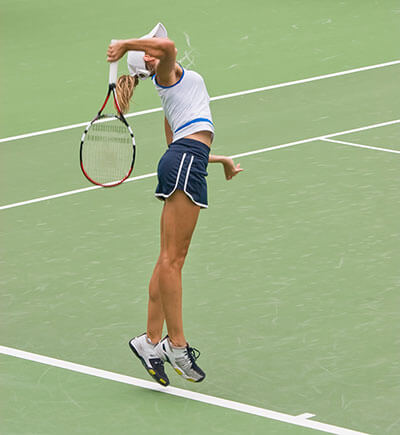Wimbledon season is upon us and you might be feeling inspired to dust off your racket. The tennis serve is a great subject for discussing biomechanics and muscle work but these theories can be applied to many other sports as well.
A well-executed tennis serve is a thing of beauty. Power rippling through the legs and torso before the arm whips the racket skywards. A perfectly directed flick of the wrist is all that’s required to send home a blistering ace.
Have you noticed though how the most powerful serves often come from relatively slight players? (think Venus) It’s not all about raw strength, power comes from being able to deliver force to the ball as fast as possible and that requires great technique.
First, you need a position to create force, knees bent, torso backwardly rotated and extended, shoulder back. Think of this phase like a preloaded catapult, a moment of stillness just before the knees extend to unleash energy from the legs. The role of the torso is purely to transmit that force from the pelvis, to the shoulder and down the arm which flicks like a horse’s tail. Massive acceleration takes place in this phase but only if the arm, wrist and hand are allowed to flow, “Loose as a goose” as local tennis coach Jason Boon is fond of saying. The tension in the arm conversely causes deceleration and is a great way to develop tennis elbow or shoulder injuries.
Back to the torso. A strong core is important, but again there must be fluid movement. A player who braces the abdominals makes the trunk stiff, leaving the shoulder to generate rotational force, possibly causing the rotator cuff muscles to become overworked and injured.
Core work will most definitely help improve your serve but Joanne Elphinston of JEMS Physiotherapy recommends that this is best done away from the court to avoid developing bracing patterns within the service action.
There are many ways to work on your core, Pilates is probably the method people are most familiar with and at Courtyard we have an extensive range of classes and 1:1 session available.
Less well known is TRX suspension training, a high-intensity exercise programme which uses your body weight to develop strength, balance, flexibility and core stability simultaneously. Suspension equipment consists of two adjustable length straps of seat-belt like material, hung from the ceiling. These allow you to adjust your body weight in relationship to gravity and work the entire body as gently or as intensively as you need.
As a footnote, I understand there is also some football going on at the moment. Don’t worry, flip things around the other way with force travelling downwards through the rotating torso. The leg now becomes the horse’s tail and, hey presto! The same theory can be applied to taking penalty kicks!
If you’d like to try one of our TRX or Pilates classes, give us a call 01453 548119 or email reception@courtyardclinic.com to arrange an assessment.

